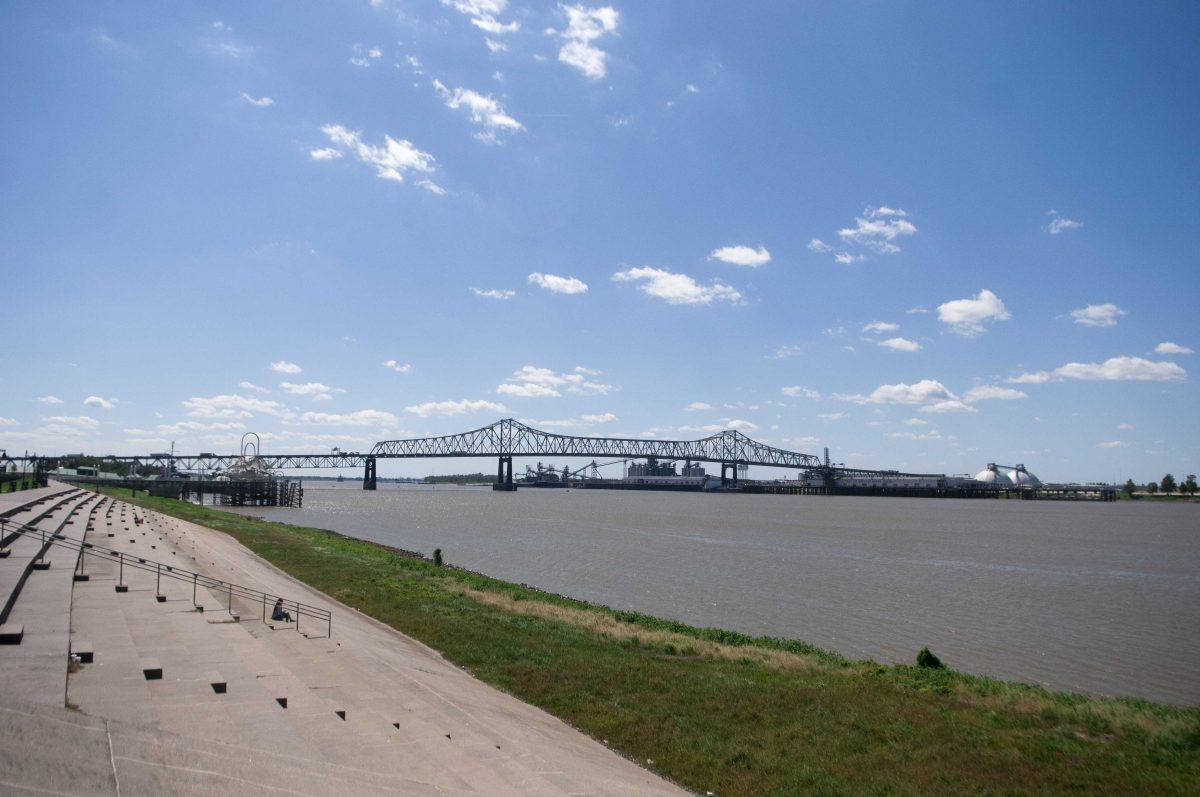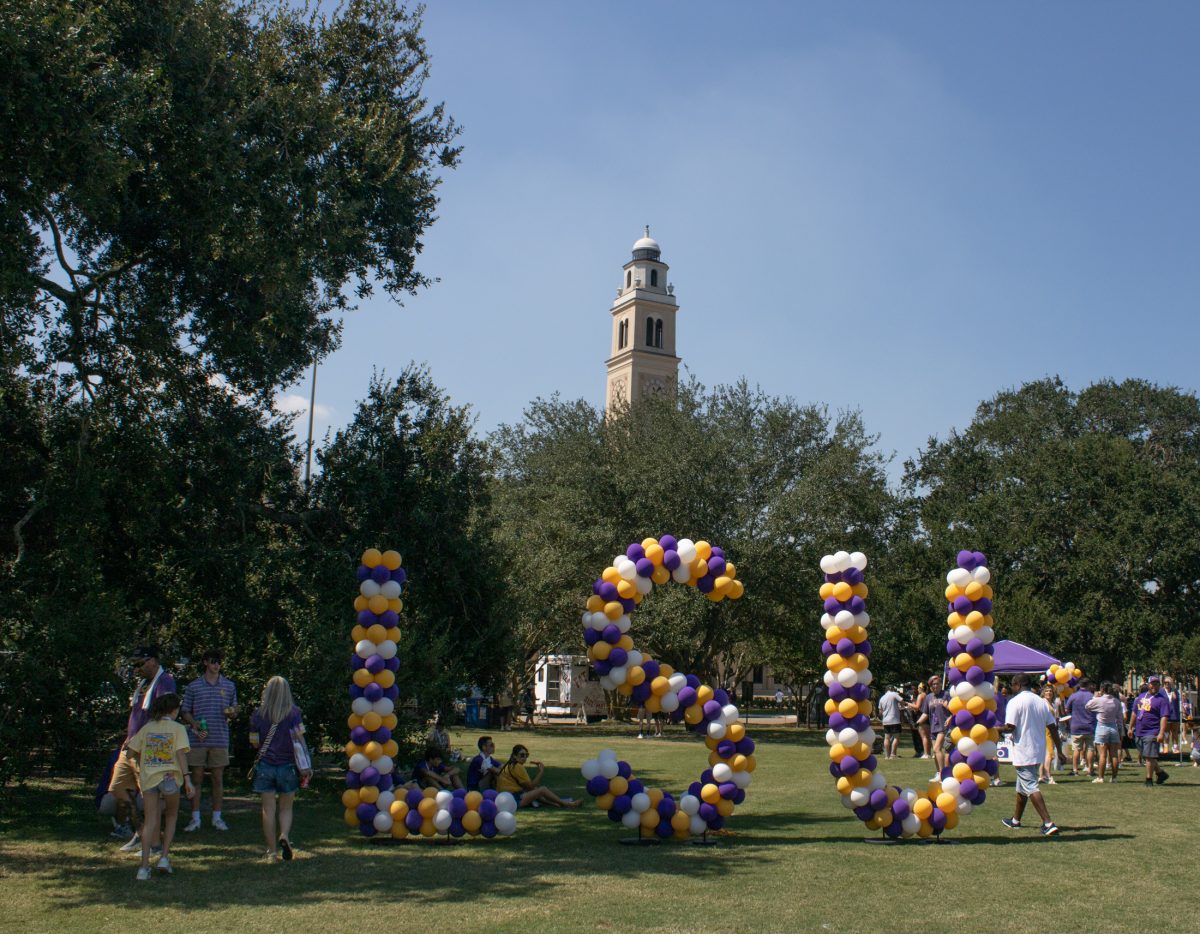In St. James Parish, a welcome sign sitting beside a gravel road is covered in reddish-brown dust called bauxite, a potentially harmful byproduct of an alumina manufacturing plant nearby.
Below the sign in white letters barely visible through the dust reads “Don’t Litter” and the phone number to report litterers. But littering is the least of concerns for residents in St. James and surrounding parishes, who are exposed to some of the highest concentrations of cancer-causing chemicals and toxic air in the country. [1, 2].
“You can see that the air is not clean,” LSU graduate student Adam Dohrenwend said.
Dohrenwend, who studies geography, is doing his dissertation on the land along the lower Mississippi River. He said the number of plants in the area shocked him while he was doing field work.
“There are fence-line communities that are right next to these plants, just divided with a little fence,” he said. “These people in these communities are basically treated like surplus space or surplus people.”
The area is known as Cancer Alley, a petrochemical corridor along the lower Mississippi River between New Orleans and Baton Rouge. More than 150 chemical plants and oil refineries occupy this stretch of land, where most communities are predominantly Black.
Some residents in St. Gabriel Parish have complained of nighttime chemical releases that result in thick yellow mists coating their yards and dead birds in their lawns. Residents are also convinced the pollution is leading to higher rates of cancer and miscarriages in the region.
Residents and activists have been fighting to keep out more chemical plants and ensure stronger air quality regulations since the early 1990s.
It’s an environmental justice problem that’s received national attention. President Joe Biden mentioned Cancer Alley while signing executive orders targeting climate change and industrial pollution during his first week in office.
Recently, the problem received international attention as well.
Experts from the United Nations’ Human Rights Council deemed new development in Cancer Alley a form of environmental racism in a press release released March 2.
The statement comes from the UN’s rapporteur on contemporary forms of racism, racial discrimination, xenophobia and related intolerances.
New petrochemical complexes in Cancer Alley have not only polluted the surrounding water and air, but also subjected its mostly African American residents to cancer, respiratory diseases and other adverse health effects, the report says.
“This form of environmental racism poses serious and disproportionate threats to the enjoyment of several human rights of its largely African American residents, including the right to equality and non-discrimination, the right to life, the right to health, right to an adequate standard of living and cultural rights,” experts on the council said.
Cancer Alley residents’ most recent fight involves keeping a $9.4 billion plastics complex, Formosa Plastics, out of St. James.
If built, it’s estimated that the plant would significantly increase levels of toxic cancer-causing chemicals in surrounding predominantly Black communities.
The cancer risks in predominantly African American districts in St. James could be at 104 and 105 cases per million, while other districts with predominantly white populations, could have a cancer risk ranging from 60 to 75 per million, according to data from the Environmental Protection Agency’s National Air Toxic Assessment map.
Industries have long flocked to the lower-Mississippi because of its easy access to shipping lanes and cheap land for large facilities.
“One of the key reasons people use to site a facility is because it’s near other facilities or it’s near an allied facility,” LSU sociology professor Kevin Smiley said. “That’s the intention. What I hear is that’s actually doubling down on a community that’s already polluted.”
Smiley researches health risks from industrial air pollution in the United States by examining the extent of disparities across metropolitan areas, and how those disparities have emerged.
Louisiana also has unique incentives, such as the Industrial Tax Exemption Program, that allow companies to pay less in property taxes than they would in other states, according to environmental sciences professor Brian Synder, who researches energy systems.
“It just becomes one of the best places in the country to build those facilities,” he said, “which has not been great for the people who live especially right on the fence-line.”
Greg Bowser, president and CEO of Louisiana Chemical Association, said racial demographics are not used to site plants.
“We do not know if this group found evidence of such actions, and if they did, the statement they released does not share that information with the general public,” he said in an interview with The Advocate.
Industries along the lower Mississippi have contended that the Louisiana Tumor Registry, the state’s cancer data aggregator, is proof that there are no adverse side effects for residents. Louisiana Tumor Registry data doesn’t show significant variance in cancer outcomes for residents in Cancer Alley.
However, the Tumor Registry also doesn’t rule out clusters of cancer outcomes in the region since the data is aggregated over irregularly sized areas across which emissions vary, according to ProPublica.
Residents and activists have argued that cancer outcomes are subject to a variety of factors, and are not the same as cancer risk, which is the highest in the country in Cancer Alley.
Environmental engineering junior and founder and director of Geaux Green, an LSU student organization devoted to sustainability, Everett Craddock said he wasn’t surprised Cancer Alley is receiving international attention.
“People who are involved in these conversations know how big of an issue this is and know how detrimental the petrochemical industry has been in that area of Louisiana,” Craddock said. “I think it’s a horrible position to put someone in to have to fight for clean air and clean water. That should be something that’s guaranteed for everyone. It’s really unfortunate that these people have been put in this position where they’re being told they don’t have a choice and that they’re going to be subjected to these conditions that are going to be impacting their health and their community.”





